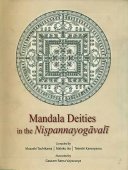Vikramashila, Vikramaśīla, Vikrama-shila: 5 definitions
Introduction:
Vikramashila means something in Hinduism, Sanskrit. If you want to know the exact meaning, history, etymology or English translation of this term then check out the descriptions on this page. Add your comment or reference to a book if you want to contribute to this summary article.
The Sanskrit term Vikramaśīla can be transliterated into English as Vikramasila or Vikramashila, using the IAST transliteration scheme (?).
In Hinduism
Purana and Itihasa (epic history)
Source: archive.org: Puranic EncyclopediaVikramaśīla (विक्रमशील).—A King praised in the Mārkaṇḍeya Purāṇa. Kālindī was his wife and Durgama his son.

The Purana (पुराण, purāṇas) refers to Sanskrit literature preserving ancient India’s vast cultural history, including historical legends, religious ceremonies, various arts and sciences. The eighteen mahapuranas total over 400,000 shlokas (metrical couplets) and date to at least several centuries BCE.
Dharmashastra (religious law)
Source: Knowledge Traditions & Practices of India: Education: Systems & PracticesVikramaśilā (विक्रमशिला) (8th–12th CE) in present-day Bihar, was among the world’s first universities. Taxila University’s different Schools taught many subjects.

Dharmashastra (धर्मशास्त्र, dharmaśāstra) contains the instructions (shastra) regarding religious conduct of livelihood (dharma), ceremonies, jurisprudence (study of law) and more. It is categorized as smriti, an important and authoritative selection of books dealing with the Hindu lifestyle.
Languages of India and abroad
Sanskrit dictionary
Source: DDSA: The practical Sanskrit-English dictionaryVikramaśīla (विक्रमशील).—Name of a monastery; Buddh.
Derivable forms: vikramaśīlaḥ (विक्रमशीलः).
Vikramaśīla is a Sanskrit compound consisting of the terms vikrama and śīla (शील).
Source: Cologne Digital Sanskrit Dictionaries: Monier-Williams Sanskrit-English Dictionary1) Vikramaśīla (विक्रमशील):—[=vi-krama-śīla] [from vi-krama > vi-kram] 2. vi-krama-śīla m. Name of a king, [Mārkaṇḍeya-purāṇa]
2) [v.s. ...] of a monastery, [Buddhist literature]
[Sanskrit to German]
Sanskrit, also spelled संस्कृतम् (saṃskṛtam), is an ancient language of India commonly seen as the grandmother of the Indo-European language family (even English!). Closely allied with Prakrit and Pali, Sanskrit is more exhaustive in both grammar and terms and has the most extensive collection of literature in the world, greatly surpassing its sister-languages Greek and Latin.
See also (Relevant definitions)
Partial matches: Shila, Vikrama, Cila.
Query error!
Full-text (+13): Buddhajnana, Atisha, Abhayankaragupta, Dharmapala, Anandagarbha, Kalyanarakshita, Surana, Bodhibhadra, Lilavajra, Shridhara, Krishnasamayavajra, Kamalarakshita, Shubhakaragupta, Shakyashribhadra, Durjayacandra, Bhavabhadra, Bhavabhatta, Tathagatarakshita, Abhayakaragupta, Nishpannayogavali.
Relevant text
Search found 17 books and stories containing Vikramashila, Vikrama-shila, Vikrama-śīla, Vikrama-sila, Vikramaśīla, Vikramasila; (plurals include: Vikramashilas, shilas, śīlas, silas, Vikramaśīlas, Vikramasilas). You can also click to the full overview containing English textual excerpts. Below are direct links for the most relevant articles:
Blue Annals (deb-ther sngon-po) (by George N. Roerich)
Chapter 6 - Six texts of Adamantine Sow (Vajravārahī) < [Book 7 - The preaching of the Tantras]
Chapter 6 - Kālacakra lineage: Kālacakrapāda senior and junior < [Book 10 - The Kālacakra]
Chapter 9 - Darpaṇa Ācārya < [Book 14 - Great Compassion Cycle]
Bodhisattvacharyavatara (by Andreas Kretschmar)
Text Section 64-65 < [Khenpo Chöga’s Oral Explanations]
Text Sections 62-63 < [Khenpo Chöga’s Oral Explanations]
Text Section 97 < [Khenpo Chöga’s Oral Explanations]
Triple Stream < [July – September, 1995]
Seats of Learning in Ancient India < [Jan - Feb 1939]
Nalanda and other Buddhist Universities in < [July – September, 1994]
Hindu Architecture in India and Abroad (by Prasanna Kumar Acharya)
Stupas in Orissa (Study) (by Meenakshi Chauley)
Tilakamanjari of Dhanapala (study) (by Shri N. M. Kansara)
7. The contemporary religious trends < [Chapter 5 - Contemporary Generative Situation]
Related products

